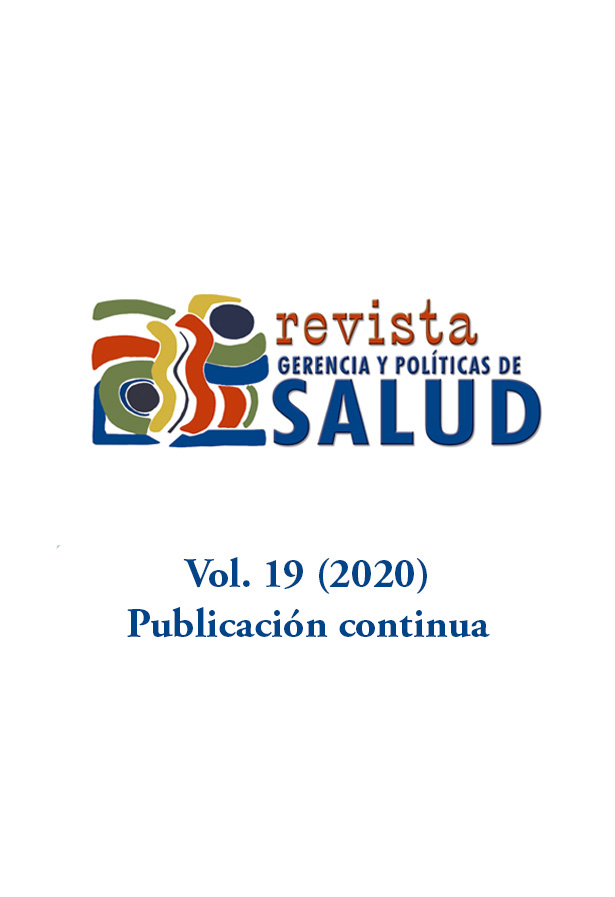Resumo
Objetivo: estudar a associação entre os fatores biopsicossociais e a Dependência Funcional (DF) nos idosos que utilizam os serviços do Instituto Nacional de Pessoas Adultas Maiores (INAPAM). Metodologia: se coletou informação a respeito das características sociodemográficas, clínicas, ambientais e pessoais dos pacientes. Além disso, aplicou-se a Avaliação de Saúde e Deficiência (WHODAS 2.0) em uma amostra de 250 idosos, do 20 de setembro ao 30 de novembro de 2017. Resultados: a prevalência geral da DF foi de 66.4%. A análise bivariada mostrou associação para o sexo feminino RM:1.8 (IC95%:1.08-3), a categoria “sem parceiro” do estado civil RM:1.9 (IC95%:1.1-3.3), a autopercepção negativa do estado de saúde RM:2.8 (IC95%:1.6-4.8), a ausência de facilitadores RM:2.6 (IC95%:1.4-5.1), a presença de barreiras RM:3.4 (IC95%:1.8-6.7) e a não assistência a consultas médicas RM:0.5 (IC95%:0.3-0.8). Conclusões: este estudo aprofunda no conhecimento dos fatores biopsicossociais da DF, mostrando de maneira sintética as interações biológicas, sociais e pessoais associadas a esta. Além disso, o estudo contribui à geração de dados a partir de uma linguagem comum em aspectos do funcionamento.
2. Consejo Nacional de Población (CONAPO). Envejecimiento demográfico en México: análisis comparativo entre las entidades federativas: La situación demográfica de México en 2015. México D.F.; 2015. http://www.conapo.gob.mx
3. Chackiel J. La dinámica demográfica en América Latina. Comisión Económica para América Latina y el Caribe. Santiago de Chile: CEPAL; 2004.
4. Alonso Galbán P, Sansó Soberats F, Díaz-Canel Navarro A, Carrasco García M, Oliva T. Envejecimiento poblacional y fragilidad en el adulto mayor. Rev Cuba Salud Pública. 2007;33(1). http://www.scielosp.org/scielo.php?script=sci_arttext&pid=S0864-34662007000100010&lng=es&nrm=iso&tlng=es
5. García-García J, Reding-Bernal A, López-Alvarenga J. Cálculo del tamaño de la muestra en investigación en educación médica. Investigación Educ Médica. 2013;2(8): 217-224. http://www.redalyc.org/articulo.oa?id=349733226007
6. Organización Mundial de la Salud - OMS. Medición de la salud y la discapacidad: manual para el Cuestionario de Evaluación de la Discapacidad de la OMS. 2015. http://apps.who.int/iris/bitstream/10665/170500/1/9874573309_spa.pdf
7. WHO. International statistical classification of diseases and related health problems - 10th revision. World Heal Organ. 2016;2(5): 1-252. https://icd.who.int/browse10/Content/statichtml/ICD10Volume2_en_2016.pdf
8. Instituto Nacional de Salud Pública (INSP). Encuesta Nacional sobre Percepción de Discapacidad en Población Mexicana 2010. Informe final de resultados. Morelos, México; 2013.
9. Moreno-Altamirano C M, López-Moreno S, Corcho-Berdugo A. Principales medidas en epidemiología. Vol. 42, Salud Publica de México. 2000 http://www.scielosp.org/scielo.php?script=sci_arttext&pid=S0036-36342000000400009&lng=es&nrm=iso&tlng=es
10. Reglamento de la Ley General de Salud en Materia de Investigación para la Salud. México DF. http://www.salud.gob.mx/unidades/cdi/nom/compi/rlgsmis.html
11. Valdespino Gómez JL, García García MDL. Declaración de Helsinki de la AMM-Principios éticos para las investigaciones médicas en seres humanos. Gac Med Mex. 2001;137(4): 391. https://www.medigraphic.com/pdfs/gaceta/gm-2001/gm014n.pdf
12. Gutiérrez JP, Rivera-Dommarco JA, Shamah-Levy T, Villalpando-Hernández S, Franco A, Cuevas-Nasu L, et al. Encuesta Nacional de Salud y Nutrición 2012. Resultados Nacionales. 2. ed. Instituto Nacional de Salud Pública; 2013. http://ensanut.insp.mx/informes/ENSANUT2012ResultadosNacionales2Ed.pdf
13. Instituto Nacional de las Personas Adultas Mayores (INAPAM). Perfil demográfico, epidemiológico y social de la población adulta mayor en el país. Una Propuesta de Política; 2015.
14. Manrique-Espinoza B, Salinas-Rodríguez A, Moreno-Tamayo KM, Acosta-Castillo I, et al. Condiciones de salud y estado funcional de los adultos mayores en México. Salud Publica Mex. 2013;55(1): 323-331. http://www.scielo.org.mx/pdf/spm/v55s2/v55s2a32.pdf
15. Secretaría de Salud. Salud Bienestar y Envejecimiento SABE Veracruz. México DF; 2012. http://www.cenaprece.salud.gob.mx/programas/interior/adulto/descargas/pdf/EncuestaSABE_Veracruz.pdf
16. Díaz-Venegas C, De La Vega S, Wong R. Transitions in activities of daily living in Mexico, 2001-2012. Salud Publica Mex. 2015;57(1): S54-61. https://scielosp.org/pdf/spm/2015.v57suppl1/s54-s61/en
17. Instituto Nacional de Estadística y Geografía - INEGI. Encuesta Nacional de la Dinámica Demográfica, 2014. México DF: INEGI; 2014.
18. Dorantes-Mendoza G, Ávila-Funes J, Mejía-Arango S, et al. Factores asociados con la dependencia funcional en los adultos mayores: un análisis secundario del Estudio Nacional sobre Salud y Envejecimiento en México, 2001. Rev Panam Salud Pública. 2007;22(1): 1-11. http://www.scielosp.org/scielo.php?script=sci_arttext&pid=S1020-49892007000600001&lng=en
Aviso de direitos autorais
A revista Gerencia y Políticas de Salud está registrada sob a licença Creative Commons Recognition 4.0 International. Portanto, este trabalho pode ser reproduzido, distribuído e comunicado publicamente em formato digital, desde que o nome dos autores e da Pontificia Universidad Javeriana sejam reconhecidos. É permitido citar, adaptar, transformar, autoarquivar, republicar e criar a partir do material, para qualquer finalidade (inclusive comercial), desde que a autoria seja devidamente reconhecida, e um link do trabalho original seja fornecido e indicar se as alterações tiverem sido feitas. A Pontificia Universidad Javeriana não detém os direitos sobre os trabalhos publicados e os conteúdos são de responsabilidade exclusiva dos autores, que preservam seus direitos morais, intelectuais, de privacidade e de publicidade.
O endosso da intervenção do trabalho (revisão, correção de estilo, tradução, layout) e sua posterior divulgação são concedidos através de uma licença para uso e não através de uma transferência de direitos, o que significa que a revista e a Pontificia Universidad Javeriana se eximem de qualquer responsabilidade que podem surgir de má conduta ética por parte dos autores. Como resultado da proteção fornecida pela licença de uso, a revista não é obrigada a publicar retratações ou modificar as informações já publicadas, a menos que a errata surja do processo de gestão editorial. A publicação dos conteúdos desta revista não representa regalias para os contribuintes.



